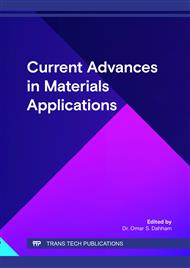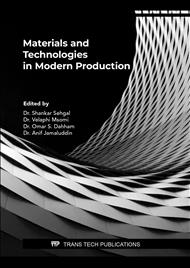[1]
Abojaradeh , M., Witczak , M. W., Mamlouk, M. S. & Kaloush, K. E. ,Validation of Initial and Failure Stiffness Definitions in Flexure Fatigue Test for Hot Mix Asphalt, Journal of Testing and Evaluation, 35) 2007( 95.
DOI: 10.1520/jte100102
Google Scholar
[2]
Al-Haddad Abdulhaq H ,The Strength of the Asphalt Binder Thin Films Thickness, Technology Reports of Kansai University 62(7) (2020) 3267-3289.
Google Scholar
[3]
Newcomb DE, Epps JA, Zhou F., Use of RAP & RAS in high binder replacement asphalt mixtures: a synthesis, Special report 213. National Asphalt Pavement Association (NAPA). Lanham, MD, USA; (2016).
Google Scholar
[4]
Mehta Y, Nolan A, Coffey S, DuBois E, Norton A, Reger D et al. High reclaimed asphalt pavement in hot mix asphalt. Final report: FHWA-NJ-2012-005. Rowan University. Glassboro. NJ, USA; July (2012).
DOI: 10.5276/jswtm.2013.234
Google Scholar
[5]
Mikhailenko P, Ataeian P, Baaj H., Extraction and recovery of asphalt binder: a literature review, Int J Pavement Res Technol. 13 (2020) 20–31.
DOI: 10.1007/s42947-019-0081-5
Google Scholar
[6]
Nösler I, Tanghe T, Soenen H., Evaluation of binder recovery methods and the influence on the properties of polymer modified bitumen, E&E Conference. Copenhagen; (2008).
Google Scholar
[7]
Rodezno C, Julian G. Asphalt binder extraction protocol for determining amount & PG characteristics of binders recovered from asphalt mixtures. Final report: WHRP 0092-16-02. National Center for Asphalt Technology at Auburn University. Auburn, USA; January (2018).
Google Scholar
[8]
Bahia , H., Hanson , D., Zeng, M., Zhai, H., Khatri, M. & Anderson , M. ,A Project NCHRP 9-10 ,Superpave Protocols for Modified Asphalt Binders, Draft Topical Report (Task 9), Prepared for National Cooperative Highway Research Program, Transportation Research Board, National Research Council , (2000).
DOI: 10.17226/14613
Google Scholar
[9]
Bahia, H. U., Zhai, H., Zeng, M., Hu, Y. & Turner, P., Development of Binder Specification Parameters Based on Characterization of Damage Behavior (With Discussion), Journal of the Association of Asphalt Paving Technologists, 70 (2001).
Google Scholar
[10]
Al-Haddad A H , Fatigue evaluation of Iraqi asphalt binders based on the dissipated energy and viscoelastic continuum damage (VECD) approaches Journal of Civil Engineering and Construction Technology, 6 (2015) 27-50.
Google Scholar
[11]
Abedali A H, Fatigue performance predication model based on dissipated energy criteria using DSR under controlled-strain mode, Innovative Infrastructure Solutions (Springer International Publishing AG, part of Springer Nature), (2018) 23 1.
DOI: 10.1007/s41062-017-0115-2
Google Scholar
[12]
ASTM D2172 / D2172M-17e1. Standard test methods for quantitative extraction of asphalt binder from asphalt mixtures. ASTM International. West Conshohocken, PA, USA,( 2017).
DOI: 10.1520/d2172_d2172m-17e01
Google Scholar
[13]
ASTM D1856-21,Standard test method for Recovery of Asphalt from Solution by Abson Method. ASTM International. West Conshohocken, PA, USA, (2021).
Google Scholar
[14]
ASTM D7175-08. Standard Test Method for Determining the Rheological Properties of Asphalt Binder Using a Dynamic Shear Rheometer. ASTM International. West Conshohocken, PA, USA, (2021).
DOI: 10.1520/d7175-05
Google Scholar
[15]
ASTM D5404 / D5404M-12, Standard practice for recovery of asphalt from solution using the rotary evaporator. ASTM International. West Conshohocken, PA, USA; (2017).
Google Scholar
[16]
Ghuzlan, K. A. & Carpenter, S. H., Energy-Derived, Damage-Based Failure Criterion for Fatigue Testing". Transportation Research Record: Journal of the Transportation Research Board, 1723, (2000) 141-149.
DOI: 10.3141/1723-18
Google Scholar
[17]
Ghuzlan, K. A. & Carpenter, S. H., Fatigue Damage Analysis in Asphalt Concrete Mixtures Using the Dissipated Energy Approach, Canadian Journal of Civil Engineering, 33, (2006) 890-901.
DOI: 10.1139/l06-032
Google Scholar
[18]
Rowe, G., Performance of Asphalt Mixtures in the Trapezoidal Fatigue Test''. Asphalt Paving Technology, 62, (1993) 344-344.
Google Scholar
[19]
Rowe, G. M. & Bouldin, M. G. ,Improved Techniques to Evaluate the Fatigue Resistance of Asphaltic Mixtures , 2nd Eurasphalt & Eurobitume Congress Barcelona, (2000).
Google Scholar
[20]
Kutay, M., Gibson, N. & Youtcheff, J. ,Use of Pseudostress and Pseudostrain Concepts for Characterization of Asphalt Fatigue Tests", Chapter 30, Pavement Cracking: Mechanisms, Modelling, Detection, Testing and Case Histories, (1993) 305-314.
DOI: 10.1201/9780203882191.ch30
Google Scholar
[21]
Kutay, M. E., Gibson, N. & Youtcheff, J., Conventional and Viscoelastic Continuum Damage (VECD)-Based Fatigue Analysis of Polymer Modified Asphalt Pavements (With Discussion)". Journal of the Association of Asphalt Paving Technologists, 77 (2008b).
Google Scholar



